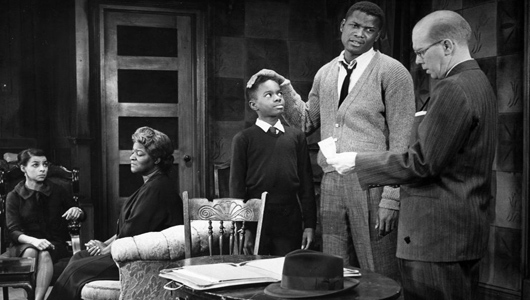
The Lorraine Hansberry drama A Raisin in the Sun opened at New York City’s Ethel Barrymore Theater on March 11, 1959.
The title comes from Langston Hughes‘s poem “Harlem” (also known as “A Dream Deferred“).”What happens to a dream deferred?” Hughes asked. “Does it dry up like a raisin in the sun?” The story is about a family’s experiences in the Washington Park subdivision of Chicago’s Woodlawn neighborhood, and is based on Hansberry’s own family history.
The author reflects on the litigation her parents pursued in her book To Be Young, Gifted, and Black:
“Twenty-five years ago, [my father] spent a small personal fortune, his considerable talents, and many years of his life fighting, in association with NAACP attorneys, Chicago’s ‘restrictive covenants’ in one of this nation’s ugliest ghettos. That fight also required our family to occupy disputed property in a hellishly hostile ‘white neighborhood’ in which literally howling mobs surrounded our house…. My memories of this ‘correct’ way of fighting white supremacy in America include being spat at, cursed and pummeled in the daily trek to and from school. And I also remember my desperate and courageous mother, patrolling our household all night with a loaded German Luger (pistol), doggedly guarding her four children, while my father fought the respectable part of the battle in the Washington court.” Hansberry was referring to the Supreme Court case Hansberry v. Lee.
With a cast in which all but one minor character is African-American, A Raisin in the Sun was considered to be a risky investment, and it took over a year for producer Philip Rose to raise enough money to launch the play.
After touring out of town to positive reviews, the play landed on Broadway. After its run at the Barrymore it transferred to the Belasco Theatre in October and closed on June 25, 1960, after 530 performances. Directed by Lloyd Richards, the cast featured Sidney Poitier (Walter Lee Younger), Ruby Dee (Ruth Younger), Ivan Dixon (Joseph Asagai), Lonne Elder III (Bobo), John Fiedler (Karl Lindner), Louis Gossett (George Murchison), Claudia McNeil (Lena Younger) and Diana Sands (Beneatha Younger). Ossie Davis later played Walter Lee Younger.
Waiting for the curtain to rise on opening night, Hansberry and producer Rose did not expect the play to be a success, for it had already received mixed reviews from a preview audience the night before. Though it received popular and critical acclaim, reviewers argued about whether the play was “universal” or particular to African-American experiences. The New York Drama Critics’ Circle named it the Best Play of 1959. The 29-year-old author became the youngest American playwright and only the fifth woman to receive this award.
Raisin subsequently went on national tour, becoming a frequently performed staple of the 20th-century American stage. It has also been filmed, turned into a musical, translated into 35 languages, and performed all over the world.
A Raisin in the Sun was the first play written by a black woman to be produced on Broadway, as well as the first play with a black director on Broadway.
Hansberry noted that it introduced details of black life under racial segregation to the overwhelmingly white Broadway audiences, while director Richards observed that it was the first play to which large numbers of black people were drawn. Frank Rich, longtime theater critic for the New York Times, stated that A Raisin in the Sun “changed American theater forever.”
In 1960 Hansberry’s play was nominated for four Tony Awards: Best Play, Best Actor in a Play (Sidney Poitier), Best Actress in a Play (Claudia McNeil), and Best Direction of a Play (Lloyd Richards).
Young, gifted and pan-Africanist
After she moved to New York in the early 1950s, Hansberry joined the staff of the Pan-Africanist newspaper Freedom, where she worked with intellectuals such as its publisher Paul Robeson and W.E.B. DuBois, whose office was in the same building. She did clerical work for the publication in addition to writing news articles and editorials.
One of her first reports covered the “Sojourners for Truth and Justice” convened in Washington, D.C., by Mary Church Terrell. She traveled to Georgia to cover the case of Willie McGee, and was inspired to write the poem “Lynchsong” about his case. She worked not only on the U.S. civil rights movement, but also on global struggles against colonialism and imperialism. Hansberry wrote in support of the Mau Mau Uprising in Kenya, criticizing the mainstream press for its biased coverage. Much of her work during this time concerned the African struggle for liberation and its impact on the world.
Hansberry often clarified these global struggles by explaining them in terms of female participants. She was particularly interested in the situation of Egypt, “the traditional Islamic ‘cradle of civilization,’ where women had led one of the most important fights anywhere for the equality of their sex.” Scholars and biographers have identified Hansberry as a lesbian, and sexual freedom is an important topic in several of her works.
In 1952, she attended a peace conference in Montevideo, Uruguay, in place of Paul Robeson, who had been denied travel rights by the State Department.
She died of pancreatic cancer on January 12, 1965, at the all too early age of 34. Her work inspired Nina Simone’s song “To Be Young, Gifted and Black.”
Hansberry’s funeral was held in Harlem on January 15, 1965. Paul Robeson and SNCC organizer James Forman gave eulogies. James Baldwin and Martin Luther King, Jr. sent messages to be read. She is buried at Asbury United Methodist Church Cemetery in Croton-on-Hudson, N.Y.
The Hansberry family house, the red-brick three-flat at 6140 S. Rhodes in Washington Park that they bought in 1937, was given landmark status by the Chicago City Council’s Committee on Historical Landmarks Preservation in 2010.
Adapted from Wikipedia and other sources.
Photo: Wikipedia (CC)










